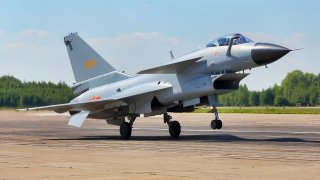China’s Chengdu J-10 Vigorous Dragon Fighter Is a 'Clear and Present Danger'
China’s Chengdu J-10 "Vigorous Dragon" is a fourth-generation multirole fighter designed to compete in the global arms market. First unveiled in 2006, the J-10 features a delta-wing design with canards, offering high maneuverability, stealth elements, and an advanced avionics suite.
Summary and 4 Points You Need to Know: China’s Chengdu J-10 "Vigorous Dragon" is a fourth-generation multirole fighter designed to compete in the global arms market. First unveiled in 2006, the J-10 features a delta-wing design with canards, offering high maneuverability, stealth elements, and an advanced avionics suite.
-Recent upgrades, including enhanced electronic warfare capabilities and off-boresight targeting, make it a competitive platform.
-Exported to Pakistan, the J-10 strengthens China's geopolitical influence, especially against India.
-With continuous improvements and AI integration for manned-unmanned teaming, the J-10 reflects China's ambitions to challenge U.S. and Russian dominance in the arms export industry.
China’s J-10 Fighter: A Rising Threat to U.S. and Russian Arms Sales
China is in a long-term strategic competition with the United States for superpower status, and Beijing has had its successes in the endeavor.
As part of the competition, China works to compete with the Americans in global arms sales, notably to the developing world.
One competing Chinese platform is the fourth-generation Chengdu J-10 Vigorous Dragon. This multirole warbird was first shown to the public in 2006.
Multiple variants of the J-10 have been created. The most recent includes radical technological enhancements to balance the capabilities of rival jets.
The Specs
Featuring a delta-wing design with canards for enhanced flight controls, this bird is highly maneuverable. While not a fifth-generation plane, like many other fourth-generation aircraft it incorporates stealth features. Its avionics suite includes an Active Electronically Scanned Array radar, significantly enhancing its air-to-air and air-to-ground engagement capacity.
The J-10C has advanced avionics such as a helmet-mounted sight and display system that is akin to the systems found in most advanced Western warplanes. This system allows for off-boresight targeting matched with Chinese-made air-to-air missiles such as the PL-10 or PL-15.
Essentially, off-boresight targeting allows a pilot to target an enemy aircraft by simply looking at it with the advanced heads-up display built into his helmet.
The J-10C has been exported to Pakistan, which is now one of the few countries that purchases Chinese military exports. Pakistan is an important nation for China for a few different reasons. First, China and Pakistan have enjoyed increased trading ties in general.
The Geopolitics
Second, both Pakistan and China are at odds with neighboring India. Their alliance, especially the increased sharing of defense technology, complicates Indian grand strategy for South Asia.
Third, Pakistan is also a conduit for Chinese power projection into Afghanistan, which China has identified as important for its foreign and economic policy.

China’s J-10 has enjoyed continuous technological improvements. One such upgrade has been in the “big spine” configuration. This has allowed for enhancements to be made to the J-10’s electronic warfare capabilities as well as for manned-unmanned team-ups. Basically, the rise of artificial intelligence has made it necessary for China to prepare their force to embrace the “system of systems” approach to warplane development.
Indeed, the most recent variants of the J-10 have seen the bird move from only an air superiority bird to a multirole fighter.
The Future of the J-10
The J-10 is a constantly evolving platform, making it highly competitive. Other states will likely want to purchase it from China.
The J-10 is the embodiment of China’s bid to displace the United States and Russia in the global arms export market. China clearly has a long road to travel. But the J-10 makes them competitive.
Author Experience and Expertise: Brandon J. Weichert
Brandon J. Weichert, a National Interest national security analyst, is a former Congressional staffer and geopolitical analyst who is a contributor at The Washington Times, the Asia Times, and The-Pipeline. He is the author of Winning Space: How America Remains a Superpower, Biohacked: China’s Race to Control Life, and The Shadow War: Iran’s Quest for Supremacy. His next book, A Disaster of Our Own Making: How the West Lost Ukraine, is due October 22 from Encounter Books. Weichert can be followed via Twitter @WeTheBrandon.
All images are Creative Commons or Shutterstock.
From the Vault
Russia Freaked Out: Why the U.S. Navy 'Unretired' the Iowa-Class Battleships
Battleship vs. Battlecruiser: Iowa-Class vs. Russia's Kirov-Class (Who Wins?)


